Not-So-Pedestrian Footbridges
Seattle span
Although they were working in an urban environment, rather than a fragile natural landscape, project team members for a recently completed pedestrian span in an industrial section of Seattle were also concerned about the disruption associated with construction. Their scheme for installing the bridge connecting the Museum of Flight's main campus with an extension involved closing a busy roadway below the new crossing for only a day.
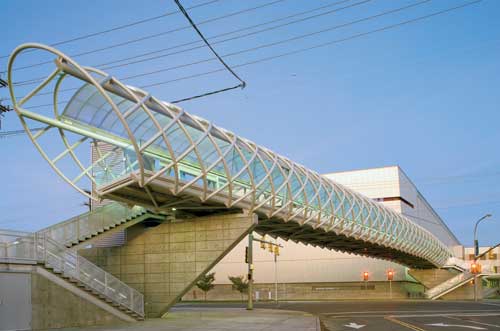 |
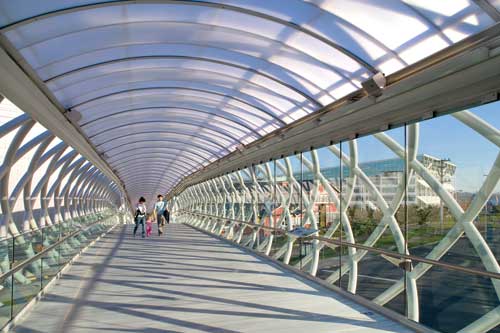 |
The main span of the pedestrian bridge at Seattle's Museum of Flight (top) is made of pipe bent into pure circles but has an elliptical section (above). Fabricators completed assembly in Tacoma (below) and transported it to the site in one piece. Photos © Lara Swimmer |
 |
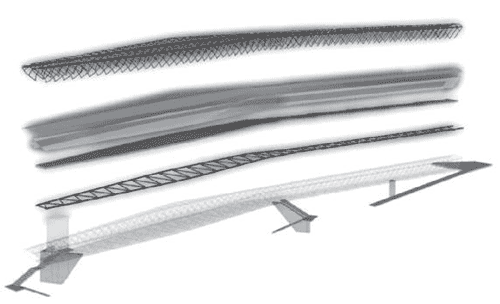 MUSEUM OF FLIGHT BRIDGE - EXPLODED AXONOMETRIC |
Â
The accomplishment is all the more noteworthy given the $6.4 million bridge's unusual design, which was inspired by the stream of crystallized vapor created in the wake of a jet, known as a contrail. "We wanted an icon that captured the spirit of flight," says architect Rick Zieve, FAIA, who is a principal in the local office of SRG Partnership.
The bridge's primary span is a 200-foot-long tube truss, about 17 feet in diameter, tapering to about 12 feet at the ends. SRG had originally hoped to make it out of pipe sections bent into ellipses. But working with structural engineers, Magnusson Klemencic Associates (MKA), in Seattle, and fabricator, Jesse Engineering, of Tacoma, Washington, the architect came up with a more cost-effective and constructible alternative: The webs are made up of two sets of 5-inch-diameter pipes bent into pure circles. These bent elements, which total more than 300 pieces, all with unique profiles, are inclined in opposite directions so that they overlap. Set inside the hooped exterior elements are four straight, 10-inch-diameter pipes serving as top and bottom chords. This crisscrossing gives the bridge an elliptical section even though its individual elements have a simpler geometry. The configuration reinforces the flight metaphor and creates the illusion that the bridge is floating, says Zieve.
In general, individual truss components can be smaller, and the overall structure lighter, if the top and bottom chords are farther apart, explains Jay Taylor, MKA principal. But at the Museum of Flight, the bridge depth was limited by the need for adequate clearance below the overhead high-voltage lines and above the roadway. Finding that "sweet spot" between component size and depth was challenging, he says.
The utilities also complicated installation. Jesse fabricated the main span in Tacoma, along with a less complex, 165-foot-long, trapezoid-shaped section. Crews transported the two fully assembled pieces to the site primarily by barge and then a short distance by truck, carefully lifting them into place under the power line by crane in only a few hours. "It was like threading a needle," says Zieve.
Contextual crossing
Architect-engineer Santiago Calatrava deployed a similar strategy for the fabrication and installation of his Ponte della Constituzione completed last fall in Venice. The 266-foot-long span, which crosses the Grand Canal and connects the city's railway station with the Piazzale Roma, was fabricated in three pieces in nearby Marghera and brought to the city by barge. Structurally, however, Calatrava's design is very different from the Museum of Flight bridge, crossing the canal with a shallow arch. The 266-foot-long span extends from stone-clad reinforced-concrete abutments and consists of a gently curved steel tube that defines the bridge's central spine and serves as the main torsion-resisting component. This central component is tied via a sculptural steel skeleton painted a bold red to an upper and lower pair of arched chords.
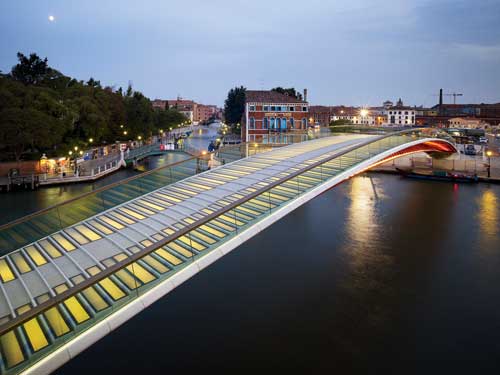 |
Santiago Calatrava's Ponte della Constituzione in Venice is an interpretation of the city's traditional stone arched bridges in modern materials. It has a sculptural steel skeleton (bottm) and a glass deck (top) that becomes a carpet of light at night. Photos © Barbara Burg + Oliver Schuh/Palladium Photodesign |
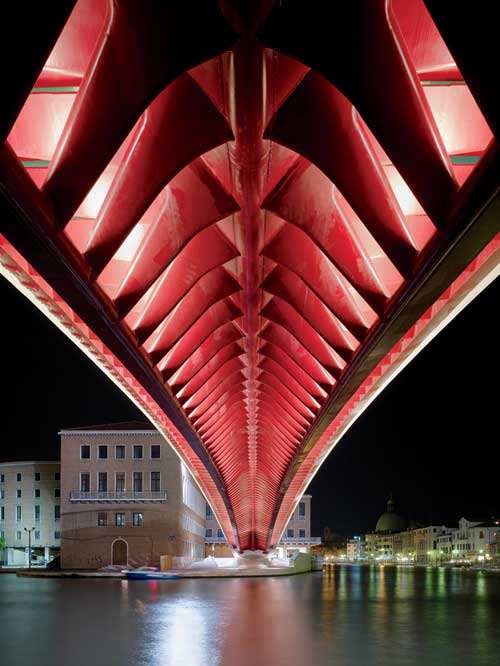 |
 |
Â
The bridge widens from about 18 feet where it meets the Canal quays to 20 feet at midspan, creating a platform for taking in the sites of the city, explains Calatrava. The crossing becomes especially dramatic at night, when the laminated-glass deck is illuminated from below, transforming it into "a carpet of light," he says.
The project has been plagued by controversy surrounding its reported $15.5 million price tag, construction delays, and other issues. Nevertheless, it is a graceful interpretation of an ancient typology indigenous to Venice in the modern materials of steel and glass. "The city has more than 400 bridges, almost all of them arches," says Calatrava. "There was no reason to do anything differently."








